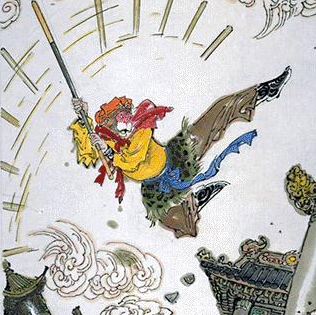
[image from a china-on-site web page]...
According to a china-on-site web page:
"... "The Monkey King" ...

[image from a china-on-site web page]...
... is the mischievous protagonist from the ancient Chinese folk tale, Journey to the West. He is born from stone and the novel follows his adventures in search of the Sutra, the Buddhist holy book. ...".
According to a Monkey King web page:
"... The Monkey King ...
... was hatched from a magical egg on a mountain top, which had been weathered and fertilised by the elements over many centuries. Made of stone and virtually indestructible (although he still feels pain), he was crowned the Monkey King after he proved to be the only monkey on the Mountain of Fruit and Flowers to dare go through the Water Curtain and set up a kingdom on Earth. ... He is immortal, having gorged himself on the life-giving peaches of the Jade Emperor's sacred garden. He is also extremely smart - he learned all the magic tricks in the world from a master Taoist, so that he is now able to transform himself into seventy-two different images such as a tree, a bird, a beast of prey or a bug as small as a mosquito so as to sneak into an enemy's belly to fight him inside or out. He can employ clouds as vehicles allowing him to travel 180,000 miles in a single somersault. He uses a Wishing Staff he got from the Dragon Kings of the Oceans as his favorite weapon - it can expand or shrink at its owner's command (he normally stores it in his earlobe). He can turns clumps of his hair into any object he desires ...[and]... can see through most illusions ...
The combination of Monkey's Taoist skills, the Peaches of Immortality, the Wine of Heaven, the food and the five bowls full of the Elixir of Long Life he consumed, had made him truly indestructible. Even when Lao Tsu put him into his Crucible of the Eight Trigrams and heated him with alchemic fire for 49 days, the only effect it had was to make Monkey's eyes permanently red. Monkey escaped and ... demanded the title "Great Sage - Equal of Heaven" - which he got (but with no salary to go with it) as it was decided the easiest way to contain his mischief was to trick him into staying in Heaven ...
At this point the Buddha intervened. The Buddha made a wager with Monkey, betting him that he could not jump out of Buddha's hand. Should Monkey win, he demanded the Jade Emperor's job; should he lose, then he would be banished to Earth for centuries to learn some humility.
Monkey cloud-flew to the end of the universe, where he saw five pink pillars, which he took to be the end of the world. On the middle pillar he wrote "The Great Sage Equal of Heaven reached this place", to prove beyond any doubt he had reached this spot ... he also urinated at the base of the first pillar. Then he returned to face the Buddha. To his shock, the Buddha informed him he had never left Buddha's hand - and to prove it, showed Monkey the writing on his middle finger and the distinctive smell at the bottom of his smallest digit. ... Buddha pushed him out of the Gate of Heaven, then Buddha changed his five fingers into the five elements (metal, wood, water, fire and earth). They became the five-peaked mountain under which Monkey was trapped, leaving only his head and hands exposed. After 500 years he was granted a chance to redeem himself by accompanying holy man Tripitaka on a journey to the West as his companion and guard. In order to keep him under control, a band of metal was put on his head that Tripitaka could cause to tighten by muttering a chant - while this couldn't hurt the indestructible imp, it would cause him extreme pain. ...
The story of the Monkey King was recorded in the epic tale "Journey to the West" by Wu Ch'eng-en (1500?-1582), a scholar-official. It is one of the best known classical Chinese novels, replete with Chinese fables, fairy tables, legends, superstitions, popular beliefs and monster stories. It was based on a true story of a famous Chinese monk, Xuan Zang (602-664). Over the space of many years he made his way on foot to what is today India, birthplace of Buddhism, where he sought the Sutra, the Buddhist holy book. On his return to China, known at that time as the Great Tang, he began to translate the sutras into Chinese, making a significant contribution to the development of Buddhism in China. ...".
"... According to Henry Louis Gates, Jr. (head of Harvard's African American Studies program), the Signifying Monkey is a trickster figure of Yoruba mythology (Esu-Elegbara in Nigeria and Legaba among the Fon in Dahomey), who became Exu in Brazil, Echu-Elegua in Cuba, Papa
in the pantheon of the loa of Vaudou in Haiti, and Papa La Bas in the loa of Hoodoo in the United States). ...".
According to an eleggua web page by Eric Davis:
"... the Yoruba deity Eshu-Elegbara (or Eshu for short), perhaps the world's most sophisticated Trickster figure ... a very similar figure, Legba, exists among the Fon in neighboring Benin ... He is ... one of the orisha ... While he embodies many obvious trickster elements-- deceit, humor, lawlessness, sexuality--Eshu-Elegbara is also the god of communication and spiritual language. He is the gatekeeper between the realms of man and gods, the tangled lines of force that make up the cosmic interface, and his sign is the crossroads. ... Eshu has a subtle and complex relationship with the Yoruba (and, subsequently, Fon) system of divination, Ifa. The process of the divination itself is eerily similar to that of the I Ching: The babalawo, or diviner, quickly passes sixteen palm nuts between his hands, and depending on how many are left, he draws either a broken or solid line in powder. He ... draws two groups of four lines each to create one of 256 possible patterns. ... In Haiti and Cuba, Legba is not the devil, but is syncretized with other saints, particularly St. Anthony, St. Lazarus (who is old and walks with a cane), and, sometimes St. Peter, the gate-keeper. Again, these correspondences are not fixed in stone, but seem to mutate as the context of the world changes. ... In his book Count Zero , science fiction writer William Gibson put the orisha in the heart of cyberspace, his computer-generated astral data plane, and it worked far better than any hoary Egyptian deity or Irish fairy would have. Gibson, who tossed in those gods when he was bored with his book and happened to open a National Geographic article on voodoo, told me in an interview that he felt "real lucky, because it seemed to me that the original African religious impulse really lends itself much more to a computer world than anything in Western religion...It almost seems as though those religions are dealing with artificial intelligence.". Gibson also pointed out how similar vévés are to printed circuits. ...".
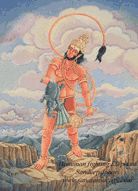
is the monkey deity renowned for his courage, power and faithful, selfless service. The Life of Hanuman is related below in the form of short numbered and illustrated accounts of some of the most important parts of his life. ... Some say Hanuman ... is the son of Anjana, an female Apsara who had been transformed into a monkey by a curse, and Vayu, the wind god. It is also said that from his father Vayu Hanuman received the ability to fly. ... Hanuman ... caught sight of the Sun and thinking it was a fruit he leapt after it. The Sun took flight but Hanuman chased him as far as Indra's heaven. ... Indra ... agreed that Hanuman should become immortal. All the gods came together to bless young Hanuman in a cave. ... As a young monkey god, Hanuman was quite naughty and abused his powers ... Ram and Sita were crowned King and Queen of Ayodhya. Obviously Hanuman was present, remained Ram's favorite general ... When Rama offered him any boon that he cared to name, he asked to live for as long as men spoke of the deeds of Rama. ...".
According to a PageWise web page:
"... The Origin of Hanuman: ... The angel Punjikasthala was an inmate in the ashram of Sage Brihaspathi. ... She was disobeying him ... The sage ... cursed her to become a female monkey and live on earth. ... The sage ... regretted his emotional action. ... He told her:'My dear daughter, you don't worry now. With the blessings of Lord Siva and Parvathi, you will soon get a son who will be respected by everyone. He will be full of virtues and will never face defeat. He will be the embodiment of knowledge, fearlessness, strength and real devotion.' With tearful eyes she bid farewell to her father. At that time, the sage told in her ears 'Anjana , Anjana'. She knew then that her name has been changed to Anjana and that she would be known here after only in the new name. ...
Then Anjana reached the dense forests on the earth and wandered aimlessly. She ... saw ripe mangos on the nearby tree. She collected a few of them and started to eat. But she heard the following anonymous words 'Anjana, don't eat anything before taking a bath and before worshipping Lord Siva and Parvathi. You should worship them in the morning and evening with full devotion. They will bless you.' She looked all around but nobody was there. She thought that these words were from a god himself and did everything as was told. Later she ate the fruits and continued her aimless journey.
Then there was a storm. All the trees started swaying heavily. ... there was a huge demon, about to swallow her. The demon in his frightening voice said 'Don't worry, lovely girl. I am Sambasadan. No one in all the three worlds is capable of facing me. If you will marry me I will protect you.' Anjana could not bear her anguish. She simply cried. Sambasadan advanced to her, but she walked backward. Then she fled. The demon followed her. Anjana, even while running, was praying loudly to Siva and Parvathi. Sambasadan was about to catch her, when suddenly she fell down. At that time she heard the loud cry of Sambasadan. She got up and looked at him. A highly poisonous snake had bitten him and he had fallen unconscious. The snake told her 'Anjana, he is not dead - just unconscious only. You may escape now.' In a moment the snake had vanished.
Anjana ran fast and reached an Asram on the top of the hill. The saints who lived there consoled her and gave her food and water. She told them her story in detail. She knew from them that Sambasadan was a dangerous demon and that he was a threat for them also. They had requested that Veerakesari, a monkey hero, kill the demon. If he succeeded all of them would be saved. Anjana again prayed to Siva and Parvathi and slept well during night in the safety of the Asram.
Next morning Veerakesari arrived there to protect the saint and their religious ceremonies. Anjana saw him and felt confident that he would kill the demon. Then suddenly there was the thundering shout of Sambasadan. Veerakesari assured the saints and Anjana that no harm would be done to them. The demon approached Anjana and pulled her to his side. She cried loudly as the demon put her on his shoulders. Veerakesari obstructed him by sending several arrows at the demon. Anjana escaped when a terrific fight ensued between them.
The demon was badly injured. Then, using his magical powers, he took the form of an elephant. It attacked the Asram and the saints. Anjana was hiding behind a huge tree. Veerakesari reduced his size, became a small monkey and jumped on the head of Sambasadan. He resumed his original huge shape and attacked the elephant in different ways. Then the demon took back his original shape and threw Veerakesari far away. Luckily he was not injured. He got up and again attacked the demon, but he was getting weaker. Anjana observed these and prayed to Siva and Parvathi for help in saving Veerakesari. At that time she heard an anonymous voice: 'Sambasadan can be killed only with his own blood. Try that'. Anjana thought of several ways. She at last took some arrows and dipped them in the blood of Sambasadan, which had formed a pool there. She gave these arrows secretly to Veerakesari. He used these arrows against the demon, and as was his fate the demon fell dead. The saints were immensely happy as the eternal problem of the demon had been solved once for all. They wanted to reward Veerakesari suitably. But, what would they offer? Finally they arrived at a decision.
The sage Panga called Anjana to his side and told her:'We have decided to give you in marriage to Veerakesari, who has saved all of us from the demon. Do you have any objection?' Anjana did not have any objection. On the other hand she had wished for it. Their marriage took place on an auspicious day.
Time passed by. Anjana did not have a baby, and the couple was sad. But they continued their usual prayers to Siva and Parvathi. They observed fasting, prayed continuously and spent all the time in devotion of these gods. At last, the gods were pleased. One day Siva and Parvathi came to Veerakesari's house in the shape of monkeys and started eating the special fruits kept for worshipping the gods. Veerakesari wished to drive away the monkeys, but Anjana did not agree. She knew that gods may come in any shape. She started praying. Veerakesari also joined her. In fact, the monkeys were Siva and Parvathi, and they were pleased.
They took their real forms and told Anjana:'There is a solitary tree in the middle of forest. You go around that tree daily. As time passes on, with the help of Vayudeva(a god of wind) you will get a ripe mango. When Anjana eats it, she will get a beautiful baby, who would be blessed by all gods and would be as fast as the wind'.
They reached the centre of the forest and found the mango tree. They did everything as advised by Siva and Parvathi, for six days. On seventh day, while they were circling the tree praying, they heard an anonymous voice: 'Anjana , Veerakesari, the god is pleased with you. The blessed time has arrived. You may take this divine mango fruit.'
The fruit had by now come down to their level, without anyone holding it. They were really afraid to take it. Again the anonymous voice said: 'I am Vayudeva ( god of wind). The mango is in my hand. It is God's will that my power is also to be mixed with the power of Lord Siva. Therefore, the son that is going to be born for will you will have courage, strength and devotion. When Veerakesari gives the mango to Anjana the child will get his power also.'
Anjana ate the mango after praying to Siva and Parvathi. Shortly thereafter, Anjana became pregnant and a male child was born in due course. Thus was Hanuman, otherwise known as Anjaneya, born.
Hanuman remained a bachelor throughout his life. He was adventurous, strong, wise, cunning, knowledgeable, a musician, highly religious, courageous, fearless and, over and above all, totally devoted to his master Sri Rama. ...".

According to The I Ching in the Shinto Thought of Tokugawa Japan.by Wai-ming Ng:
"... Hayashi Razan (1583-1657) ... pointed out that both Shinto and the I Ching favored the number eight, because it reflected the mystery of the numerology of the universe. ...
... Kumazawa Banzan (1619-1691) ... developed a cultural perspective that treated both the I Ching and the Three Regalia as symbols of the divine way of heaven and earth ... The most striking similarity between the I Ching and Shinto, he believed, was that they both favored the number eight, which reflected the universality of the divine way of heaven and earth ...[Banzan said:]... "the Three Regalia and the three lines [of a trigram] of the I Ching are alike." ..."... The Chinese sage, Fu Hsi, was the first to draw the lines of ch'ien and k'un, which were later developed into the six lines, the eight trigrams, and [eight times eight to produce] the sixty-four hexagrams. Similarly, we [Japanese] used the number eight in words, such as the Yatano [Mirror] and the Yasaka [Jade], because the divine way of heaven and earth is one, and it is naturally the same wonderful principle shared by both Japan and China. ..."
... Watarai Nobuyoshi (1615-1690) ... used the I Ching and the Nihon shoki to explain every detail of the Age of the Gods. For instance, Izanagi and Izanami were represented by the hexagrams ch'ien and k'un. He believed that these two books were equally important, because they shared a similar idea of the way of heaven, earth, and human beings ...
... Kikkawa (Yoshikawa) Koretari (1616-1694) ... used the theories of t'ai-chi and yin-yang wu-hsing to construct his theological and ontological views. He identified Kuni-no-tokotachi-no-mikoto, the first Shinto deity who appeared after the beginning of the universe, as t'ai-chi, and Izanagi and Izanami as the gods of Yang and Yin. ...
... Hirata Atsutane (1776-1843) ... asserted ... "[Fu Hsi] was actually a god of our holy land, Omono-nushi-no-kami, who went to exploit that land [China] and cultivate the foolish people. In order to teach them the way of human relations, he went [to China] for a short period, and acquired this Chinese name. ... our god, Omono-nushi-no-kami, also called Taiko-fukki-shi, granted [the Chinese] the Ho t'u and Lo shu (Writings from the River Lo), and created the wonderful trigrams ... Based on the images of oracle bones, he invented Chinese characters. ... " ... Atsutane alleged that the I Ching was modified by Shen Nung and Huang Ti (the Yellow Emperor), both of whom he claimed were Japanese deities, and held that the modified I Ching later became the Lien Shan and Kui Ts'ang. These two early forms of the I Ching were also transmitted orally and adopted by the Hsia and Shang dynasties, respectively. Atsutane blamed King Wen, the founder of the Chou dynasty, for changing the order of the hexagrams and the number of yarrow stalks to justify the revolution that overthrew the Shang regime. ... Atsutane rearranged the order of the hexagrams, and reduced the number of yarrow stalks from forty-nine to forty-five, believing that he had restored the ancient I Ching. ..." ...
... Ikuta Yorozu (1801 -1837), a faithful disciple of Atsutane's, believed ... the ancient I Ching ... was the work of a Japanese deity called Okuni-nushi-no-kami, who felt' pity for the Chinese when he saw their stupidity. As a result, this kami went to China, and wrote the I Ching to enlighten them: "... This happened four thousand eight hundred and eighty-some years ago. ..." ...".
According to an aikiwest web page:
"... the symbolism of triangle, circle, and square
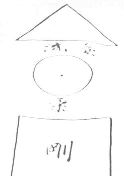 (Fig.
4)
(Fig.
4)
... illustrate[s] the principle of ichirei-shikon-sangen-hachiriki, "One-Spirit, Four-Souls, Three-Fundamentals, and Eight-Powers," a framework that ... was present in every religious cosmology. ...
According to the book Ghost in the Shell 2: Man-Machine Interface by Masamune Shirow (a pseudonym) (Dark Horse Comics 2005):
"... Instability occurs every thousand years in the three trees of the Jizaiten space-time universe. ... Jizaiten ... is represented by three "tree" or "forked" structures, called sansagi. There are sixty-four strata of irrreversibly ordered elements that move in precise sequence about the three trees, and one full cycle of their movement is equivalent to the life of the universe. ...".
According to a wikipedia web page on Japanese mythology: "... Japanese mythology ... embraces
and Buddhist traditions ... In the beginning, when heaven and earth were still chaotic, three and then two deities appeared in Takamanohara (high in heaven). They are called the Kotoamatukami (deities of distinguished heaven) and play very little part in most myths. They are neutral in the gender and are essential forces that move the world.
In addition, two and five pairs of deities ... called Kamiyonanayo (Seven generations of Kami) ... appeared on the earth.
The first two, Kuninotokotachinokami (The god that perpetually exists as a nation) and Toyokumononokami (The god of rich clouds and fields), like five deities before, are neutral.
The other five pairs are made from a pair of a male deity and a female deity ... the last pair ...[were called]... Izanagi and Izanami ...
While standing on the bridge, Amenoukihashi (floating bridge of heaven) between heaven and earth, the god Izanagi and the goddess Izanami, churned the sea with the spear decorated with jewels given from Amatsukami, Amenonuhoko (heavenly spear) and from the salt dripping from the spear, Onogoro (selforming) island formed itself.
Even though there should be nothing on the island, they mated in the Yahirodono (the room of eight footsteps?) around the pole Amenomihashira and bore many islands and deities. The first two, Hiruko (waterly child) and Awashima (island of bubbles) were badly made as Izanami had called to Izanagi instead of Izanagi calling to Izanami ... They reversed this process on the call from Amatsukami, making sure it was the male god Izanagi who spoke first rather than Izanami. This successful encounter brought about the ohoyashima, or the eight great islands of the Japanese chain. ... They bore six more islands and many deities.
Izanami was killed ... giving birth to the child Kagututi (incarnation of fire) or Ho-Masubi (causer of fire). In anger, Izanagi killed Kagututi. His death also created dozens of deities. ... Izanagi ... created ... gods ... Amaterasu (incarnation of the sun) from his left eye, Tukuyomi (incarnation of the moon) from his right eye, and Susanowo (incarnation of wind or storm) from his nose. Izanagi went on to divide the world between them with Amaterasu inheriting the heavens, Tsukiyomi taking control of the night and moon and the storm god Susanowo owning the seas. ...
... Amaterasu, the powerful sun goddess of Japan, is the most well-known deity of Japanese mythology. Her feuding and uncontrollable brother Susano, however, is equally infamous ... Susano ... hurled a pony into Amatarasu's weaving hall causing the death of one of her attendants. Amaterasu fled and hid into the cave called the Iwayado. As the incarnation of the sun disappeared into the cave, darkness covered the world. ... it took the combined presence of the myriad of gods and the sensual dances of the dawn goddess Ama-No-Uzume to bring Amaterasu out of the cave and once again shine her light to the world. ...
.... Izanagi ... banished ... Susano ... to Yomi ... the shadowy land of the dead ...
... Ohonamuji (also known as Ohokuninushi) was a descendant of Susanowo ... Although the Yamato tradition attributes the creation of the Japanese islands to Izanagi and Izanami, the Izumo tradition claims Ohonamuji, along with a dwarf god called Sukunabiko, would contribute or at least finish the creation of the islands of Japan. ...".
According to a buhhdamuseum web page about netsuke: "...
and is frequently depicted with the peach of longevity as in the Chinese Taoist tradition. ...".
According to a jref web page: "... Kasuga Taisha Shrine... built by the Fujiwara family in 768 ... is one of the most important in Japan. In accordance with the Shinto need for purification, the shrine is destroyed and rebuilt every 20 years, like the Great Shrine of Ise. Kasuga Taisha is situated in Nara Park, just east of Todai-ji. ... The Kasuga Matsuri or "Monkey Festival" is held on 13 March ...".
According to a Terry Keith McCombs web page: "... Oh-Kuni-Nushi ... also Okuninushi no mikoto, Okuninushi no kami, Onamuchi no mikoto, Ookuninushi ...[has symbols]... Koto (Japanese harp), Bowl, Bow & Arrow, Sword ...[and rules]... Healing, Medicine, Sorcery, the Unseen World. Resourcefullness, Compassion ... The Human world we know is called Ashihara no Nakatsukuni and came about when Ohkuninushi shed a ray of light on what had been an area of only darkness and chaos. He also pioneered it placing lands ... and making it livable for animals, humans, and spirits. ... Susanno ... the powerful God of Storms ... gave ... Ohkuninushi ... his magic Koto, bowl, sword, bow & arrow ...". Sussano had cut the sword from a dragon: According to a wikipedia web page on Japanese mythology: "... the dragon named Yamatano-oroti ... had eight heads and eight tails ... It ... was slain by Susanowo ... A nearby river turned red with blood of the dragon. As Susanowo cut the dragon into pieces, he found an excellent sword from a tail of the dragon that his sword had been unable to cut. The sword was ... named as Kusanagi (Grasscutter). ...".
For a time, Ohkuninushi ruled Izumo and Amateru ruled the rest of Japan, but, according to a Hotsuma-Tsutae Book of Heaven (Chapter 10) web page: "... the will of the Lord Amateru ...[was that]... There can only be one ... Ohonamuchi resigned himself to leaving Izumo ...[saying]... "My sons have departed, and so I will also. And in case, after I have gone, there should be any other who rises up in defiance, I present to you my Kusanagi halberd with which to smite them. With this shall you keep this land under your rule." ...". The result was, according to a web page about the Kami of Shinto: "... the visible world would be the domain of ...[the children of] ... Amaterasu ... and things hidden (Suku-na-biko's medical knowledge, exorcism, and the occult) would be the province of the children of Susano ...[Ohonamuchi] ...".
According to a web page by Carrie Ferber: "... The Shinto kami O-Kuni-Nushi-no-Kami is also called Onamochi or O-Mono-Nushi-No-Kami. ... O-Kuni-Nushi is known to be a god of abundance, medicine, and good sorcery, and happy marriages. ...[In]... the legend of the white hare of Inaba ...
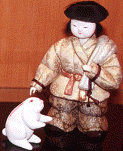
... The hare has been skinned by a group of vicious crocodiles, when he asks O-Kuni-Nushi's brothers for help and they tell him to bathe in the sea and to dry off in the wind. This causes severe pain for the Hare. Later, the hare meets O-Kuni-Nushi, who feels sorry for the animal and tells him to bathe in fresh water and then to roll in the pollen of sedges lying on the ground. After this the Inaba Hare is completely cured. In thanks he proclaims that the Princess Yamato is to go to O-Kuni-Nushi, not to his brothers. His brothers are angry with this and kill O-Kuni-Nushi, which they succeeded in doing, but his mother and the goddess Kami-Musubi manages to resurrect him ...".
According to a web page by Russell Cooley: "... Ninigi no Mikoto ... was ... Grandchild of ... Amaterasu ... sent to earth by Amaterasu ...[to]... rule ... she bestowed on Ninigi the Imperial Regalia (consisting of the sacred Yata no Kagami, or Eight-Handed Mirror, the curved Yasakani no Magatama Jewel, and the Sword Kusanagi no Tsurugi).
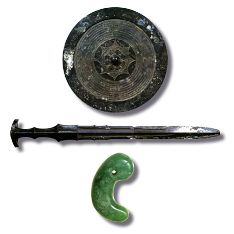
This mirror had been the very one that the heavenly Kami had used to entice Amaterasu out of her rock cave, thus restoring light to the world. The Yasakani Jewel was among those that had hung on the sacred sakaki tree that the Kami had placed in front of the rock cave for the same purpose. And the Sword Kusanagi was the one that Susano-O had retrieved from the tail of the Orochi dragon ...".
Motoko Kusanagi of Ghost in the Shell is named for the Sword Kusanagi.
Each of the Yasakani no Magatama Jewel correspond to half of a Yin-Yang Tai Chi

and 8 of them are on this Magatama Necklace ( from Inuyasha anime )
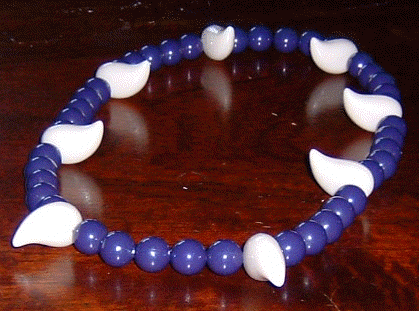
with 8 + 40 = 48 total beads.
According to an Earth Language web page: "... Hotsuma-Tsutae ...[is]... an long epic about very ancient Japan written by syllabics ... Matsumoto Yoshinosuke ... got a facsimile ... part of Hotsuma at a secondhand book shop in Tokyo in 1966, and ... published a book about the report in 1980 ... In [19]92 ... Ibo Takao who had known this was cleaning the inside of Hie shrine ...[and]... found the original all 24 volumes of Hotsuma in three very old wooden boxes of 'heaven', 'human' and 'earth'; there were Chinese translation together and all were written by Waniko Yasutoshi in 1775. The Ibo family has very old tradition in the west of Biwa Lake( the largest lake in Japan, not far from Kyoto ), and the discoverer Takao was the head of the family and knew that the writer was called Ibo Konosin too, his seventh generation ancestor. ...
... The following is my hypothesis getting hints from books and the web sites above and other books which I have here.
There is a place called Awa-tsu( tsu means ancient port ) in the west of the lake. In the bottom of the lake, there is a remain of stone age people's lives. Awa means millet grains. The pre-rice people might plant Awa there, seasonably praying the heaven for rain to the earth where millet grew at the ridge of the mountain above there. The Hotsuma book has the song of A-WA first, as A = heaven and Wa = earth. Maybe they thought that the result of tying of heaven and earth powers are the millet: A-Wa = awa. In the 6th century, their specially sacred place was Mt. Ushio ( the east ridge of Mt. Hiei where is now the Tendai Mikkyo Buddhism Enryaku-ji Temple; one main place of middle era Buddhism ), and a little later, they enshrined the Hie great shrine in the bottom; it became the origin of all Sannow Shinto shrines in Japan. The shrine where Hotsuma was discovered was a branch of it near there. The origin of Ibo's family was the god of Mountain and the family has strongly related to Hie shrine and Mt. Hiei Buddhism society in the middle era ( by Mr. Takabatake's mail ). I found that there is a huge mound tomb named 'Hiko-Ushio'( perhaps ancient meaning was great king. Hiko was added for male name ) too in the town where Mr. Ibo lives.
On the other hand ... there are many ancient Korean style tombs with horizontal hole chambers and Kasuga-yama group of tombs which are recognized as Wani family's whose ancestor was told as the founder of Han dynasty of Chinese. A history dictionary says that they immigrated to Japan and served for writing for imperial society since around the 5th century. The family name Waniko sounds like Wani + ko( child ). Waniko Yasutoshi wrote that his motivation of his job of Hotsuma was in his grandfather, but his Ibo grandfather died before his birth, and he used another family name: perhaps it was his maternal grandfather. If my guess is right, Waniko Yasutoshi had to have many materials of very old written traditions from both very old families. I guess the following three cases are possible for the birth of Hotsuma symbols and the epic.
I think it needed a big reason to invent these rational symbols ... Also if it was much before 1), one who only knew a language couldn't have this rational idea, without any comparison. So for the reason, I imagine 2) or 3). ... The real remained thing of Hotsuma Tsutae was made by Yasutoshi in 1775, but the pieces of ideas and maybe the writing system also could be centuries older, and anyway many materials were compounded together by Yasutoshi ( he took 30 years ), I think. In the Edo era, paper was completely recycled, so after renewed writings, perhaps old one must be recycled, and you can't find older version; you can't prove which guess was true. ...".
According to a Hotsuma-Tsutae web page: "... The Hotsuma-Tsutae is an epic poem of more than 10,000 lines written in "yamato-kotoba", an ancient form of Japanese. It tells the story of the "gods" who inhabited Japan in the Late Jomon, Yayoi, and Early Kofun eras (spanning more than a thousand years from the 8th century BC to the 3rd century AD). Its authors are given as Kushimikatama, Minister of the Right in the reign of the Emperor Jimmu, and Ohotataneko, who lived during the reign of the Emperor Keiko. Kushimikatama wrote the first two volumes (The Book of Heaven and The Book of the Earth). Ohotataneko edited these and added the third volume (The Book of Man). ... CONTENTS OF THE HOTSUMA-TSUTAE ... Awa-no-Uta The Awa-no-Uta is a song that starts with the letter "a" and ends with "wa", hence its name. It contains each character in the 48-syllable script of ancient Japan (the "Hotsuma script"), and appears in the first chapter of the Book of Heaven. ... The Book of Heaven (Chapters 1-16) ... The Book of the Earth (Chapters 17-28) ... The Book of Man (Chapters 29-40) ...".
According to a Hotsuma-Tsutae web page about Awa-no-uta: "... Isanagi and Isanami, the 7th generation of rulers ... revived the productivity of agriculture ...[and]... set about standardizing the national language, which had become polarized into barely intelligible dialects. To do this, they employed a form of song called the Awa no Uta.
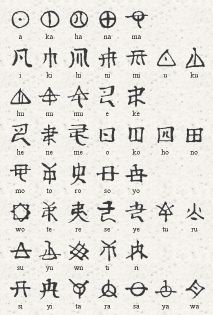
Singing in harmony to the accompaniment of musical instruments, Isanagi would intone the "upper" 24 sounds and Isanami the "lower" 24. In this way, they tried to standardize the number of sounds in the language and, along with their efforts to diffuse agriculture, this helped them bring the nation back to its feet. ...".
Note that the upper 24 plus lower 24 can represent the 48 root vectors of the F4 Lie algebra, which form in 4-dimensional space a 24-cell
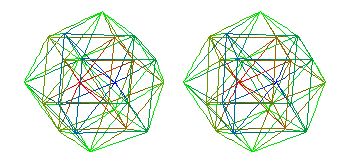
and its dual
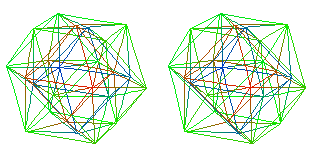
24-cell.
According to a Hotsuma-Tsutae web page about Futomani: "... Toyoke, lord of the northern provinces ... drew up a chart using 51 phonetic symbols to represent the 49 deities residing in the heavens.
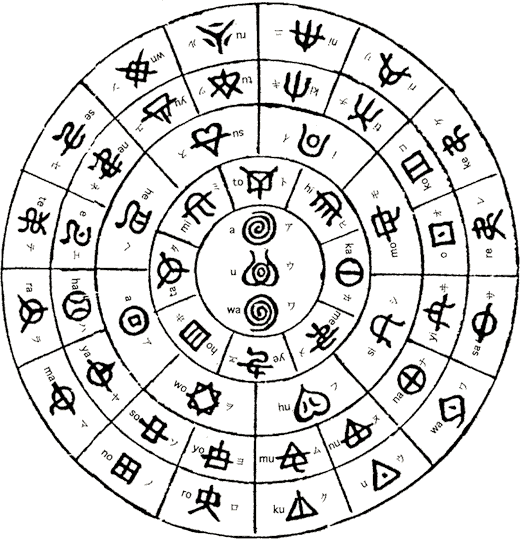
This he presented to his daughter Isanami and her spouse Isanagi, 8th in the line of divine rulers of Japan. Amateru, son of Isanagi and Isanami, had his nobles compose poems based on Toyoke's chart. From these, he selected 128, which were then set down as the Futomani Book of Divination (the origin of Shinto divination rituals).
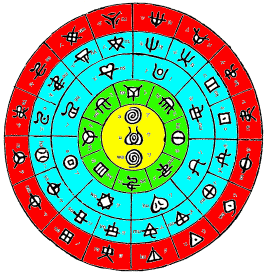
Note that the 16+8 = 24 cyan letters can represent the 24-cell root vectors of the 28-dimensional D4 subalgebra of the F4 Lie algebra; the 8 green letters can represent the vector space of D4; and the 8+8 = 16 red letters can represent the 16 full spinors ( 8 +half-spinors and 8 -half-spinors) of D4.
The diagrams in the yellow center are
not Hotsuma letters, but are symbols of left-handed
and right-handed spirals and a double spiral. If the double
spiral is counted twice, as representing Yin and
Yang of a Yin -Yang symbol  ,
then there are 4 elements, corresponding to the 4 Cartan subalgebra
elements of the 48+4 = 52-dimensional
Lie algebra F4.
,
then there are 4 elements, corresponding to the 4 Cartan subalgebra
elements of the 48+4 = 52-dimensional
Lie algebra F4.
Amateru's 128 poems correspond to two sets of the 64 hexagrams of the I Ching.
They also correspond to half of the 256 Odu of IFA, and to the 128-dimensional even subalgebra Cl(8)e of the 256-dimensional Cl(8) Clifford Algebra with graded structure
1 8 28 56 70 56 28 8 1
The graded structure of even subalgebra Cl(8)e is
1 28 70 28 1
which can be written in two dual 64-dimensional parts as
1 28 35
35 28 1
in which the first 28 corresponds to the 28-dimensional D4 Spin(8) Lie algebra whose 24 root vectors correspond to 24 of the 48 Hotsuma letters and to the vertices of a 24-cell

and in which the second 28 corresponds to the momentum space duals of the 28-dimensional D4 Spin(8) Lie algebra whose 24 root vectors correspond to the other 24 of the 48 Hotsuma letters and to the vertices of a dual 24-cell

Note that the 128 contains two dual 24-cells whose 24+24 = 48 vertices form the root vectors of the 48+4 = 52-dimensional exceptional Lie algebra F4.